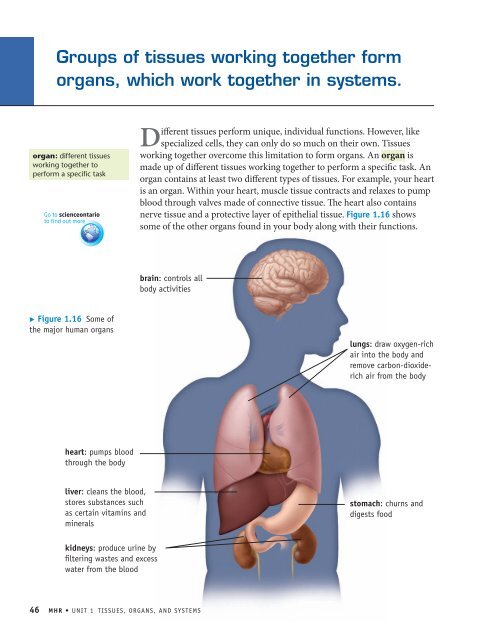How do cells work together in the human body? - McGraw-Hill ...
How do cells work together in the human body? - McGraw-Hill ...
How do cells work together in the human body? - McGraw-Hill ...
Create successful ePaper yourself
Turn your PDF publications into a flip-book with our unique Google optimized e-Paper software.
Groups of tissues <strong>work</strong><strong>in</strong>g <strong>toge<strong>the</strong>r</strong> form<br />
organs, which <strong>work</strong> <strong>toge<strong>the</strong>r</strong> <strong>in</strong> systems.<br />
organ: different tissues<br />
<strong>work</strong><strong>in</strong>g <strong>toge<strong>the</strong>r</strong> to<br />
perform a specific task<br />
Different tissues perform unique, <strong>in</strong>dividual functions. <strong>How</strong>ever, like<br />
specialized <strong>cells</strong>, <strong>the</strong>y can only <strong>do</strong> so much on <strong>the</strong>ir own. Tissues<br />
<strong>work</strong><strong>in</strong>g <strong>toge<strong>the</strong>r</strong> overcome this limitation to form organs. An organ is<br />
made up of different tissues <strong>work</strong><strong>in</strong>g <strong>toge<strong>the</strong>r</strong> to perform a specific task. An<br />
organ conta<strong>in</strong>s at least two different types of tissues. For example, your heart<br />
is an organ. With<strong>in</strong> your heart, muscle tissue contracts and relaxes to pump<br />
blood through valves made of connective tissue. The heart also conta<strong>in</strong>s<br />
nerve tissue and a protective layer of epi<strong>the</strong>lial tissue. Figure 1.16 shows<br />
some of <strong>the</strong> o<strong>the</strong>r organs found <strong>in</strong> your <strong>body</strong> along with <strong>the</strong>ir functions.<br />
bra<strong>in</strong>: controls all<br />
<strong>body</strong> activities<br />
Figure 1.16 Some of<br />
<strong>the</strong> major <strong>human</strong> organs<br />
lungs: draw oxygen-rich<br />
air <strong>in</strong>to <strong>the</strong> <strong>body</strong> and<br />
remove carbon-dioxiderich<br />
air from <strong>the</strong> <strong>body</strong><br />
heart: pumps blood<br />
through <strong>the</strong> <strong>body</strong><br />
liver: cleans <strong>the</strong> blood,<br />
stores substances such<br />
as certa<strong>in</strong> vitam<strong>in</strong>s and<br />
m<strong>in</strong>erals<br />
stomach: churns and<br />
digests food<br />
kidneys: produce ur<strong>in</strong>e by<br />
filter<strong>in</strong>g wastes and excess<br />
water from <strong>the</strong> blood<br />
46 MHR • UNIT 1 TISSUES, ORGANS, AND SYSTEMS

















